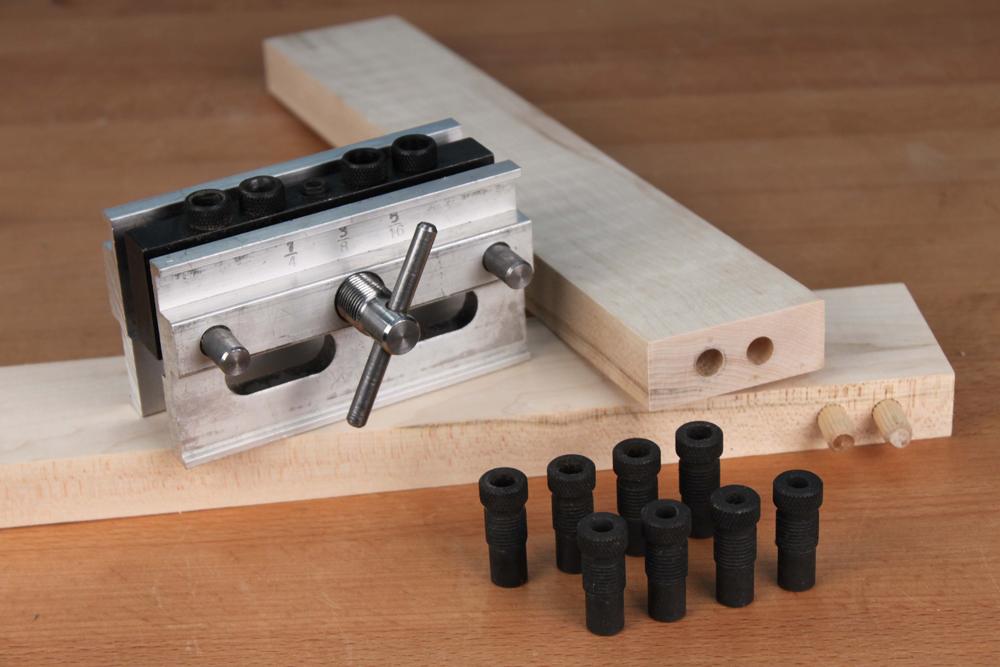 I use dowels to assemble parts quite often; things like face frames, table bases, and chairs. Trying to drill and align the dowel holes without a decent dowel hole drilling jig is futile. This dowel jig (see Source below) is the latest version of a long-time favorite of mine. It has 4 threaded holes and 3 sets of 4 threaded bushings so you can easily drill precisely spaced 1/4″ dia., 5/16″-dia., or 3/8″-dia. holes. The advantages this dowel jig has over previous iterations are subtle, but once you use it those benefits become obvious. It offers lots of flexibility, accuracy, and for reasons I’ll show you here, using it can save you a lot of time and dowel hole alignment frustrations.
I use dowels to assemble parts quite often; things like face frames, table bases, and chairs. Trying to drill and align the dowel holes without a decent dowel hole drilling jig is futile. This dowel jig (see Source below) is the latest version of a long-time favorite of mine. It has 4 threaded holes and 3 sets of 4 threaded bushings so you can easily drill precisely spaced 1/4″ dia., 5/16″-dia., or 3/8″-dia. holes. The advantages this dowel jig has over previous iterations are subtle, but once you use it those benefits become obvious. It offers lots of flexibility, accuracy, and for reasons I’ll show you here, using it can save you a lot of time and dowel hole alignment frustrations.
Why use dowels?
OK, I’ll admit there are a billion and one ways to assemble pieces of wood, and I say if it works, it’s good, so why use dowels? Honestly, if I can use a biscuit, I do, and if I want a “purist” joint, I cut a mortise and tenon, but if I want fast, inexpensive, and strong joints, I use dowels. I don’t own expensive joint making machines because I just don’t have enough need to justify the cost.
A brief history of self-centering dowel hole drilling jigs
I recall a long time ago in a different century when I first set eyes on this style of dowel hole drilling jig. It was beautiful learning that, for a very reasonable price, I could finally drill straight and centered dowel holes. It looked almost exactly the same as this model, but it lacked the threaded holes and bushings, so it could only drill one hole at a time. Problem with that is it takes 2 dowel pins to properly join a stile and rail joint, so drilling the second hole, and then getting all 4 holes of a joint properly aligned was hit or miss. Some years later the next version of this jig appeared with 2 threaded holes and 3 pairs of different sized bushings. The 2 threaded holes were set at a 3/4″ spread. This was a huge step forward. Now both holes could be drilled with one clamping setup of the jig. As with all jigs this style the jig must be clamped to enough material width so there’s no racking of the jig faces (see the photo Do it this way! below). Using this version of the jig meant aligning and clamping it to one face, drill that pair of holes, flip the jig around, align and clamp it to the face of the other rail, and then drill that pair of holes. Drilling dowel holes in stile edges presented similar jig flipping issues. It was the need to layout on both stile faces, and the flipping the jig around that severely slowed down the work. For years I never thought it could get better than that, until now! This version, with its 4 thread holes and 12 bushings, adds a new level of ease. Now all holes can be drilled relative to one face, so layout and jig alignment are greatly simplified. Timesaving is the biggest benefit, but wood component alignment is improved too since all the holes are drilled relative to the same face eliminating the need for the jig to be 100% perfectly centered. Keep reading to see and understand these benefits better.
Drilling dowel holes in rail ends
This jig really shines when you need to join face frame stiles and rails when the rails are less than 2″ wide. No other inexpensive dowel hole-drilling jig that I know of can match the ease and accuracy of this tool. I can drill 16 holes to join a simple 4-piece face frame in a matter of minutes. First of all…
Don’t do this!
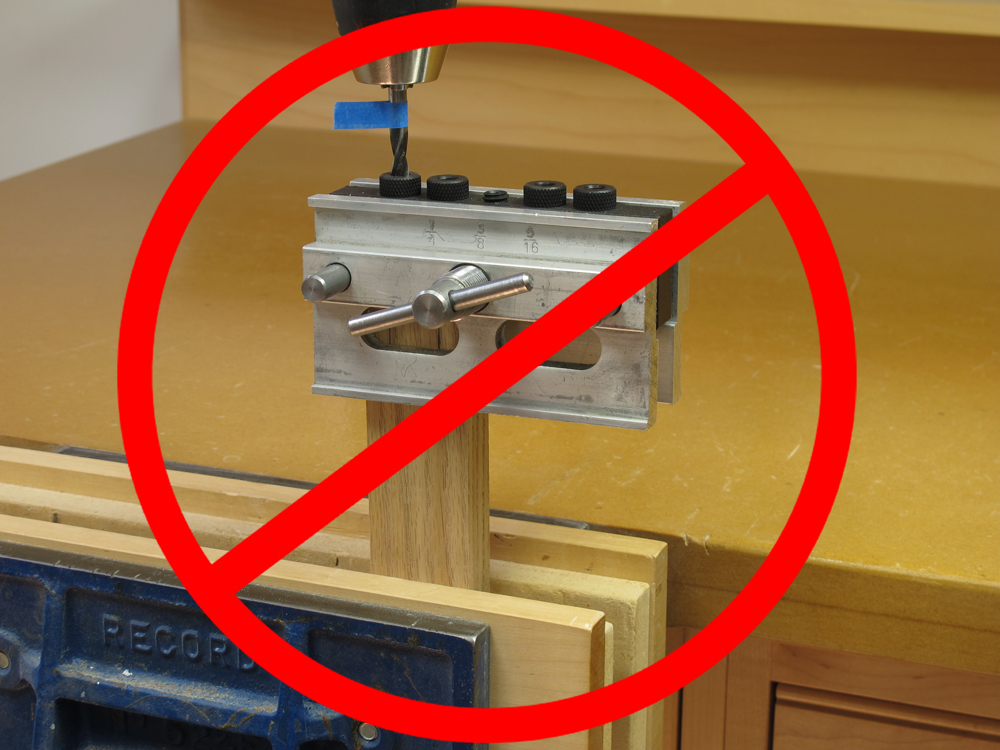 Intuitively you would think clamping the jig to one rail end to drill the holes should be fine, but it’s not. The faces of the jig will rack, and then the jig only clamps on the rail’s edge closet to the jig center. The more pressure you apply, the worse it gets. Instead…
Intuitively you would think clamping the jig to one rail end to drill the holes should be fine, but it’s not. The faces of the jig will rack, and then the jig only clamps on the rail’s edge closet to the jig center. The more pressure you apply, the worse it gets. Instead…
Do it this way!
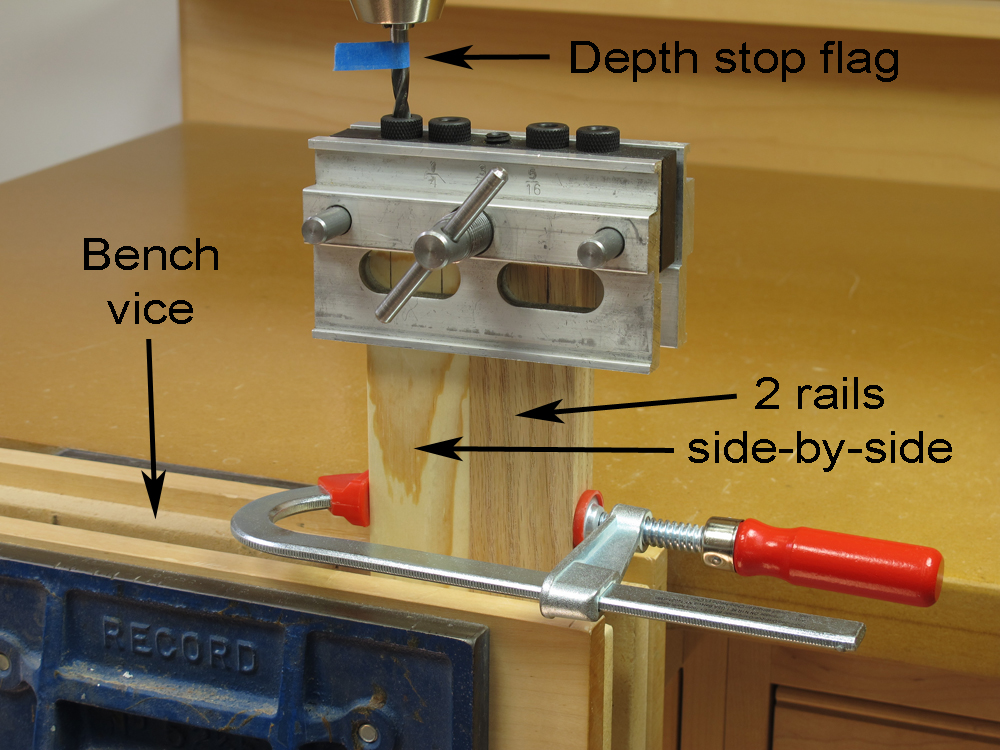 Set up and drill holes in rail ends like this. Clamp 2 or 3 rails together to create a wide clamping surface for the jig. Align the jig to the marks on the left rail face, and using the left set of bushings, drill that pair of holes.
Set up and drill holes in rail ends like this. Clamp 2 or 3 rails together to create a wide clamping surface for the jig. Align the jig to the marks on the left rail face, and using the left set of bushings, drill that pair of holes.
Shift the jig left.
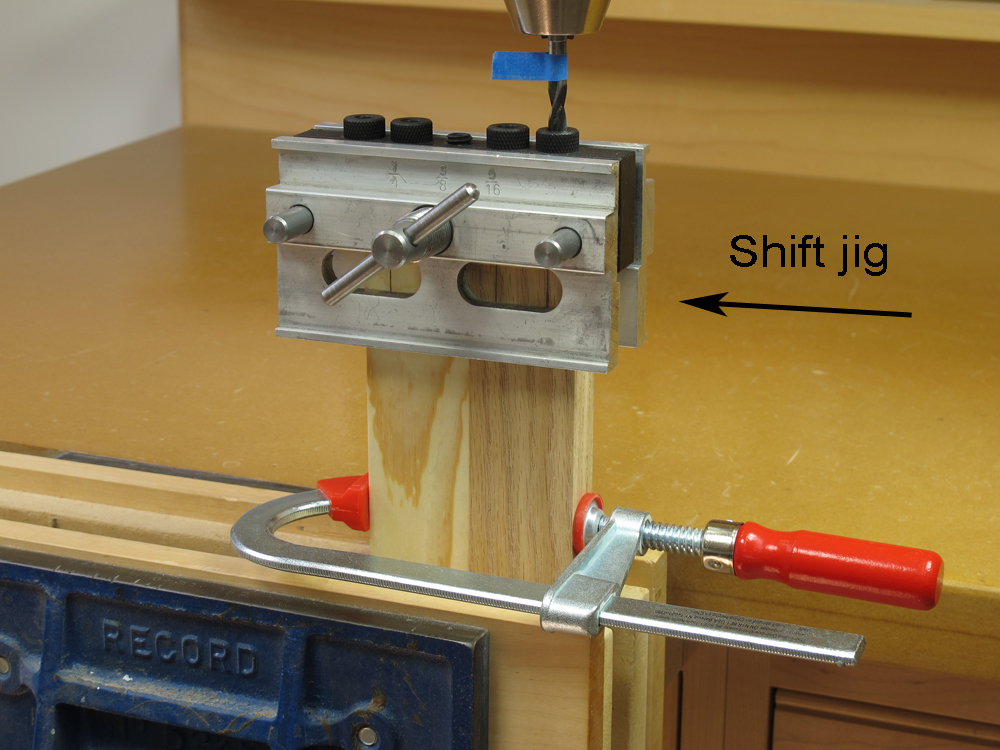 Align the jig with the marks drawn on the right rail, and use the right set of bushings to drill that pair of holes. It’s the second set of bushings that’s the key to eliminating the darn jig flipping. Just a slight shift to the jig leftward, clamp again, and drill!
Align the jig with the marks drawn on the right rail, and use the right set of bushings to drill that pair of holes. It’s the second set of bushings that’s the key to eliminating the darn jig flipping. Just a slight shift to the jig leftward, clamp again, and drill!
Drilling dowel holes in stiles
Slide the jig
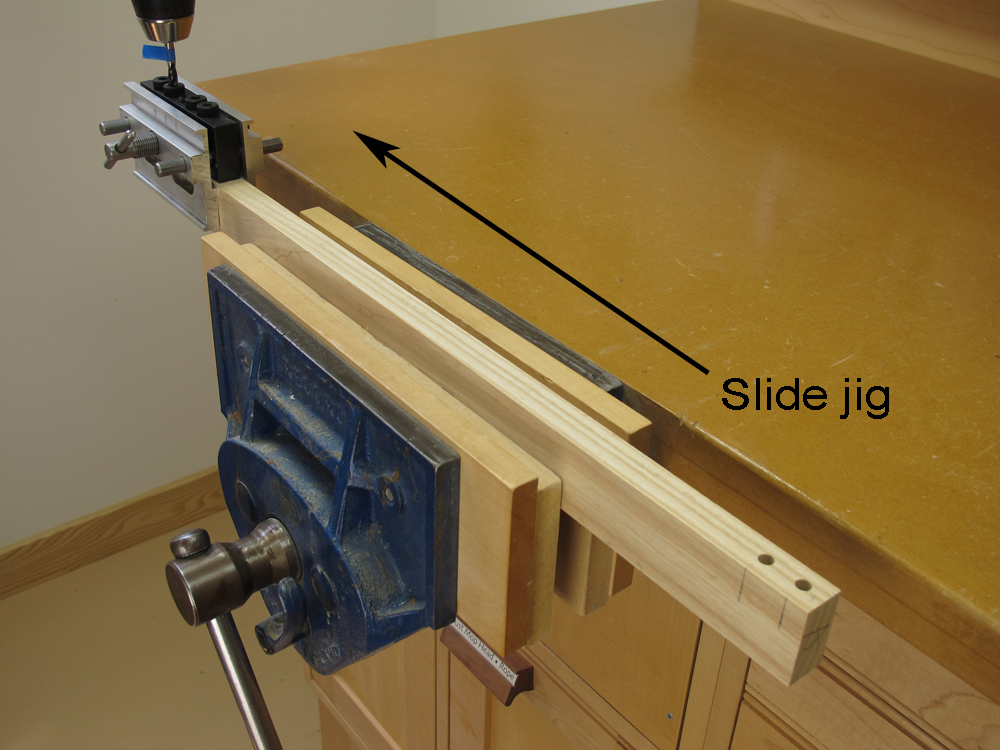 Slide the jig to the other end and drill the pair of holes there. You use the other set of bushings on the jig so again there’s no need to flip the jig around.
Slide the jig to the other end and drill the pair of holes there. You use the other set of bushings on the jig so again there’s no need to flip the jig around.
Wider spacing possibilities
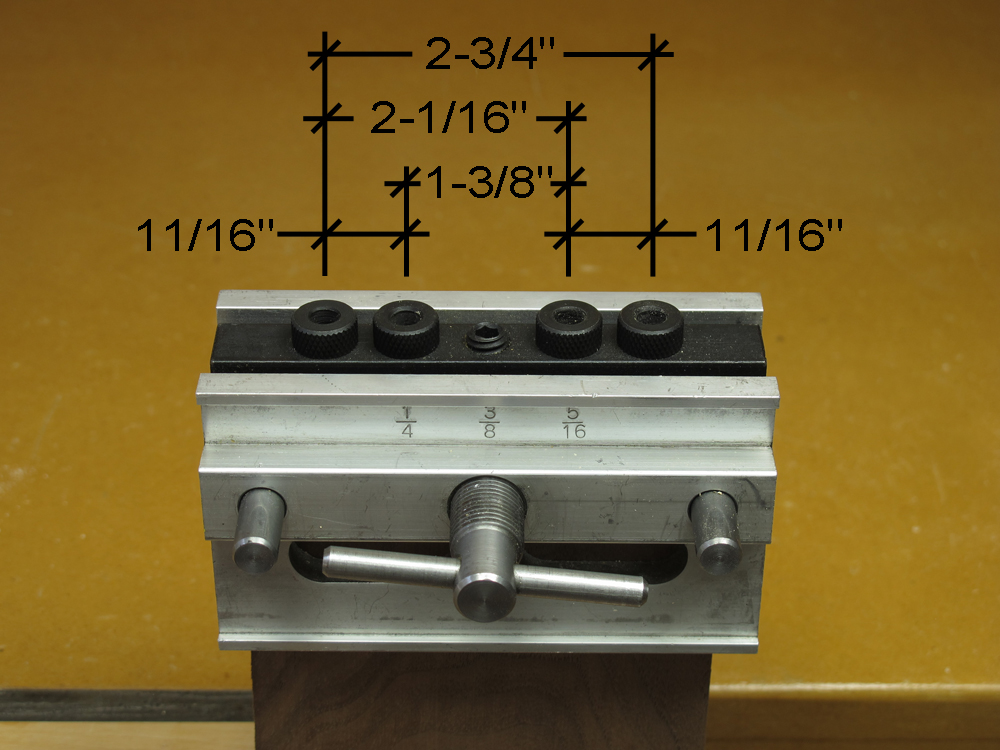 One other benefit of the 4 threaded holes is you actually get 4 different pre-set spacing options. The wider spreads are great for wider rails and aprons. Note that this jig’s end holes are set at an 11/16″ spread. For simplicity, I still draw my layout marks at 3/4″ centers, and then just align the jig equally side-to-side on those marks.
One other benefit of the 4 threaded holes is you actually get 4 different pre-set spacing options. The wider spreads are great for wider rails and aprons. Note that this jig’s end holes are set at an 11/16″ spread. For simplicity, I still draw my layout marks at 3/4″ centers, and then just align the jig equally side-to-side on those marks.
Potential pitfalls
The biggest problem you face using dowels is getting the dowels to fit properly in the drilled holes. Dowel pin diameters are notoriously inconsistent, and drill bit diameters are not consistent either. Forcing a tight dowel pin into a hole that’s too small will certainly split a rail or stile end. The mistake most woodworkers make when they encounter tight dowel pins is to grab a cordless drill and bit, and ream out the drilled holes. Unfortunately, that will destroy the alignment of the wood parts and weaken the assembled joint. The best solution is two-fold; Use the largest diameter drill bit you can find that still fits through the size jig bushing you plan to use to drill your dowel holes, drill a few test holes in hardwood, and then purchase “fresh” dowel pins that fit into those holes. As a last resort, you can sand or shave down the diameter of your offending dowel pins so they fit, but that takes a lot of time. The proper fit is achieved when you can insert and remove the dowel pin by hand and there’s no play.
Source
Dowel Making Jig with 1/4″, 5/16″ & 3/8″ Inserts, item #100-200
Infinity Cutting Tools $49.50
https://www.infinitytools.com (877) 872-2487
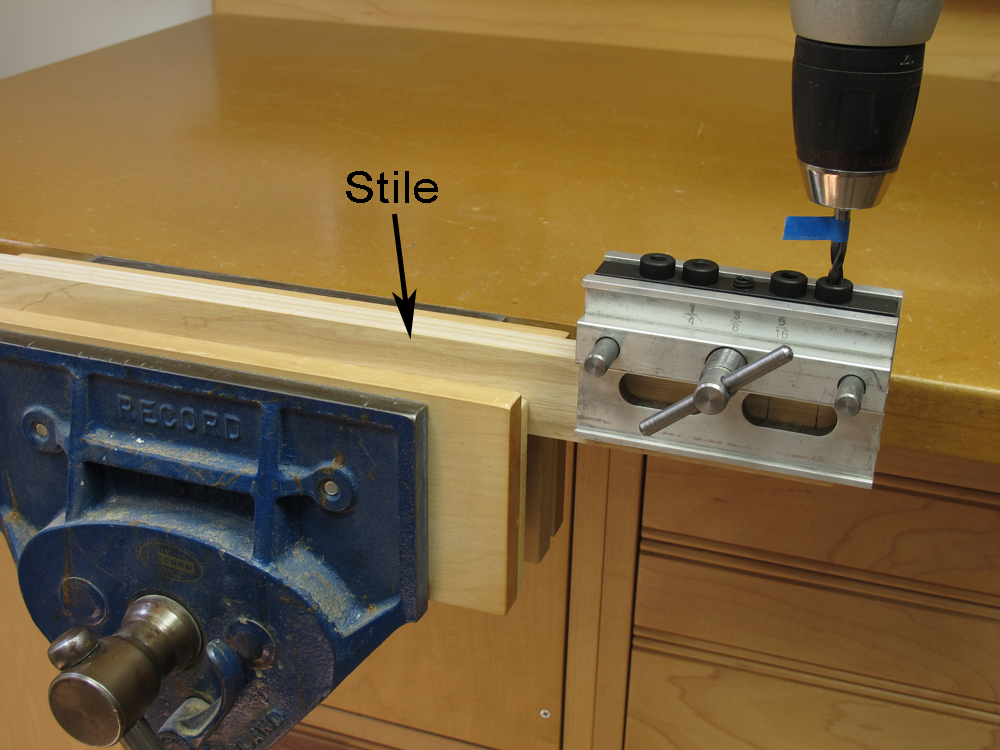
[…] 4. Self-centering dowel jig: an old favorite gets better. […]
Great article you made on wood doweling, but I was wondering if you have heard of the new doweling tool called the Dowel Wizard. This neat little tool has really simplified the process of positioning and drilling dowel holes easily, fast and accurately. No more tedious measuring, marking and cranking a T-handle for adjust to different wood thicknesses, plus it’s self-centering. I encourage you to look at the website – www.dowelwizard.com – and discover more about this new rugged precision tool. If you are interested in evaluating the Dowel Wizard, I’d be more than happy to send you one free of charge.
I love woodworking projects. And my hobby is also woodworking and crafting. I love to do create new thing passionately. You post teach me a lot about how to do woodworking accurately and how to use dowel jigs. Some days ago, I bought my first dowel jigs from https://www.bestdoweljigs.com/ . After reading this post, I'll start a new project with this shared guidelines. Thanks for sharing a wonderful post with us.
I just bought a Dowel Wizard and I love it. Ingenious design, very accurate, fast and very well built. And very reasonably priced compared to Dowelmax. Check it out.
If your looking for a doweling jig that is the easiest to use, most accurate then check out my website www.dowelwizard.com
Where is this doweling jig made? USA or Taiwan?
3960 504729The certain New york Diet can be an highly affordable and versatile eating far better tool built for time expecting to loose fat along with naturally maintain a healthful everyday life. la weight loss 568874
Please look over my website and give me your opinion of this new product.
I saw your review on the doweling tool the other day with a great deal of interest, and I wondered if you were aware of the "Dowel Wizard". This is a very unique tool that is also for positing and drilling holes for dowel pins just recently brought on the market. I believe the Dowel Wizard has addressed most of the problems that are experienced with many of the doweling jigs on the market today. Check out my website www.dowelwizard.com and let me know what you think. If you would like a sample for your own evaluation, please let me know and I'll send you one. I look forward to hearing from you, Best regards Gordon
How do you use the self-centering dowel Jig to drill on the flat portion of the board?